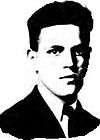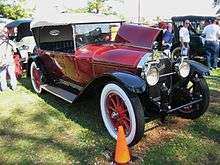Owen Ray Skelton
Owen Ray Skelton (February 9, 1886 – July 20, 1969) was an American automotive industry engineer and member of the Automotive Hall of Fame.[1][2]
Owen Ray Skelton | |
|---|---|
 Owen Skelton | |
| Born | February 9, 1886 |
| Died | July 20, 1969 (aged 83) |
| Occupation | engineer, automobile designer |
| Political party | Democrat |
| Signature | |
Early life
Skelton was born on February 9, 1886, his family living in Edgerton, Ohio, at the time.[3][4] His parents were James G. Skelton and Sophia Skelton.[5] James was a shopkeeper selling horse harness and saddlery, and the future automotive engineer worked as a shop apprentice in his youth. Eschewing horses, he graduated from Ohio State University with a degree in mechanical engineering.[6][7]
Career
From 1905 until 1907, Skelton's first automotive job was with the Pope-Toledo automobile factory in Toledo, Ohio, noted for their cutting-edge gasoline-powered engine technology. Skelton advanced to the design drafting department at Detroit's Packard Motor Car Company. As he gained experience and then expertise, Skelton simultaneously gained the reputation of being a design analyst who understood the entire transmission of a car, and a master specialist in rear axles and gear boxes.[3][6][7][8]
Moving to a startup firm, Skelton was a ground-floor partner in design for Benham from 1914 to 1916. Although the Benham automobile failed to sell, its construction appealed to another automaker also interested in streamlined design, Studebaker. The South Bend firm's vice president and chief engineer, Frederick Morrell Zeder, offered Skelton an engineering position. Skelton accepted Studebaker's pay offer of 58 U.S. cents per hour.[9] The money-losing Studebaker needed to produce a speedy design for a new, inexpensive, mass-market automobile that could compete with the two new automobile conglomerates, Ford Motor Company and General Motors. The struggling firm set up a design shop in Newark, and gave a relatively free hand to the shop's three principals, Zeder, Skelton, and Carl Breer. The threesome became known as "The Three Musketeers" for their pathbreaking design work for the 1918 Studebaker.[3][6][7][8] Pioneer design engineer Skelton's Newark residence, the Robert Treat Hotel, survives.[10]
ZSB Engineering

In 1921 Zeder, Skelton, Breer, and several associates left Studebaker to start an independent Newark automobile design-and-engineering firm, "ZSB Engineering." The luxury-oriented Daniels Motor Company hired ZSB to design their 1922 V-8,[11] but the high-end car listed for $7,450 (in 1922 dollars), a prohibitive price for that day. Later in 1922, ZSB turned their eyes toward the mass market, hired by Billy Durant on a motor design for the Flint automobile. The ZSB-designed six-cylinder engine with an updraft carburetor was later used on the Locomobile, a luxury automobile built by Durant Motors. Skelton and ZSB in the same year "shopped out" a conceptual car design, tentatively called the "Zeder." ZSB failed to obtain financing to complete the design work as an independent firm, but news of their work reached the ears of an aggressive carmaking executive, Maxwell's Walter Chrysler. This contact proved to be decisive to Skelton's career.
Chrysler obtained financing in early 1923 to merge Maxwell, the Detroit-based Chalmers Motor Car Company, and ZSB Engineering. The merged firm's operations were consolidated in Detroit in June 1923, initially under the name of "Maxwell-Chalmers."[12] With ZSB's six-cylinder engine design as an integral element, Maxwell-Chalmers's cars sold well, and the firm underwent rapid expansion under CEO Chrysler's leadership. In 1925 Maxwell-Chalmers became the Chrysler Corporation.[13]
Chrysler Corporation
As a chief design engineer for Chrysler, Skelton is credited with leading the development of a rubber engine mount system for cars. Directed to develop ideas to reduce motor vibration, Skelton's team conceptualized more than 1,000 separate ideas;[14] the Chrysler team combined the best concepts into a new system known as "floating power." The rubber engine mounts and other components of the system significantly reduced the transmission of engine vibration to the passenger compartment, thus smoothing the ride.[14][15] This Skelton/Chrysler engineering innovation spread throughout the automobile industry.[9][16]
Skelton also led the innovative development of four-wheel hydraulic brakes as a standard feature on Chrysler cars. His work continued to be significant in development of the rear-engine, all-steel-body Chrysler cars developed through the 1930s and into the postwar years, as Chrysler took its place as a full-fledged competitor to Ford and GM.[2][9]
Later life and honors
In 1931, Skelton became a vice-president of the newly founded Chrysler Institute of Engineering. It had close ties to the University of Michigan, and awarded degrees in engineering subjects.[17] Skelton became a member of the Chrysler board of directors in 1937. He served as a director until 1954, three years after he retired from his position as an engineer with the company. He died on July 20, 1969, in Palm Beach, Florida.[3][18] Skelton was named to the Automotive Hall of Fame in 2000.[2]
Family
Skelton was married; he and his wife Edna were parents to at least two children.[19]
References
- Breer, p. xi.
- "Owen Skelton/Hall of Fame Inductees". Automotive Hall of Fame. 2000. Retrieved 13 December 2012.
- Wright. "Owen Skelton, Executive Engineer". Allpar. Retrieved 16 December 2012.
- Curcio, p. 271.
- 1900 U.S. Census; Census Place: St Joseph, Williams, Ohio; Roll: 1332; Page: 12A; Enumeration District: 0113; FHL microfilm: 1241332.
- Hyde, p. 106.
- Curcio, pp. 271–272.
- Breer, p. 7.
- The Encyclopedia of America Business History and Biography (The Automobile Industry 1920–1980), Zeder-Skelton-Breer Engineering by Richard P. Scharchburg; p. 503
- Curcio, p. 289.
- Curcio, pp. 281–282.
- The Encyclopedia of America Business History and Biography (The Automobile Industry 1920-1980), Zeder-Skelton-Breer Engineering by Richard P. Scharchburg; p. 505
- Curcio, pp. 294–301.
- The 1931 Plymouth PA: Walter Chrysler's Fistful of Aces
- Curcio, p. 477.
- Popular Science (magazine), March 1932, p. 89
- "Chrysler Institute of Engineering". allpar.com. Retrieved 22 December 2012.
- "Owen R. Skelton". New York Times. July 21, 1969. p. 51.
- 1940 U.S. Census; Census Place: Grosse Pointe Farms, Wayne, Michigan; Roll: T627_1828; Page: 16A; Enumeration District: 82-68B.
Bibliography
- Breer, Carl; Yanik, Anthony J, Editor; SAE Historical Committee (December 1994), The Birth of Chrysler Corporation and Its Engineering Legacy (illustrated ed.), Warrendale, PA 15096-0001: Society of Automotive Engineers, ISBN 1560915242 Check date values in:
|year= / |date= mismatch(help)CS1 maint: location (link) CS1 maint: ref=harv (link) ISBN 978-1560915249 - Curcio, Vincent (2001), Chrysler: The Life and Times of an Automotive Genius (illustrated ed.), Oxford University Press, ISBN 0195147057CS1 maint: ref=harv (link)
- Weiss, H. Eugene (2003), Chrysler, Ford, Durant, and Sloan: Founding Giants of the American Automotive Industry (illustrated ed.), McFarland, ISBN 0786416114CS1 maint: ref=harv (link)
- Hyde, Charles K. (2003), Riding the Roller Coaster: A History of the Chrysler Corporation (illustrated ed.), Wayne State University Press, ISBN 0814330916CS1 maint: ref=harv (link)